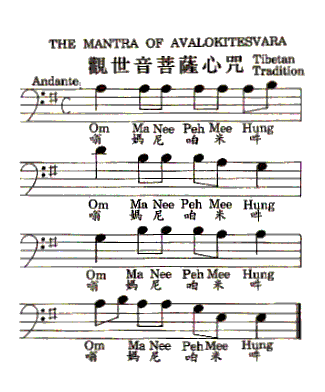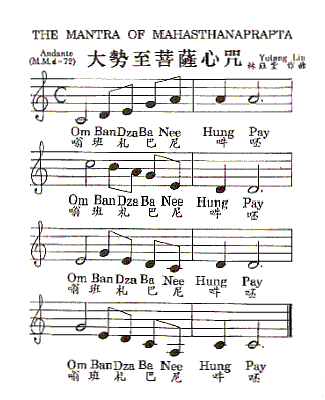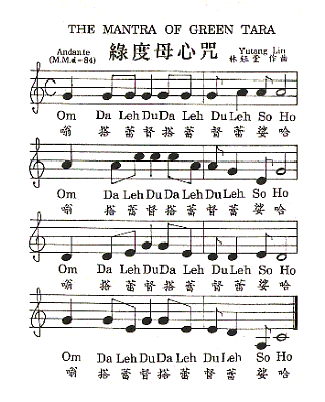淨土樂集
林鈺堂
目 錄 |
淨土樂集序言 Preface |
1、唱阿彌陀佛咒曲的觀想 A Visualization for Singing the Mantra of Amitabha |
2、阿彌陀佛心咒:嗡、阿彌答哇、啥 |
3、彌陀聖號:阿彌陀佛 Amitabha: A Mi Ta Ba |
附錄 心氣合一的念佛妙法 Unification of Mind and Wind: A Wonderful Method of Chanting Amitabha |
淨土樂集序言
林鈺堂
佛號譜曲,唱來發乎肺腑,動人心弦,既易淨化自心,更能薰陶社會,功德昭彰。古德因此流傳五會念佛之唱法;西藏傳統亦有觀音心咒「六字大明」之曲調。「五會念佛」余曾出小冊簡介。六字大明曲十分優雅,收入本集。
邁阿密佛學社佛友為使西方三聖皆有佛曲宣揚,而嘗試編作大勢至菩薩咒曲。余聞之即自然唱出一曲,但余不識樂理,只得三句,且節拍不明。蒙宋光恕老師指正,再自唱成四句。此乃本集中該曲之由來。
嘗聞四字四音彌陀聖號之曲,簡易平穩,有助道業,因此收入本集。台灣桃園湯松義居士廿餘年來放生逾百萬命。他在信中自述有此曲之錄音帶一卷,每次放送此曲之後,錄音帶已取出機外,仍可聞此曲十分鐘之久,並且屢試不爽。
三聖之咒,觀音、勢至皆已譜曲,若彌陀獨缺,良能無憾?余乃先訂此咒觀想之法,以全法界之法身光明上昇下注促使中脈開發;再唱出此曲。
觀音化身綠度母之咒,流傳普遍。余於習定座餘,先依六字大明首句唱出此咒首句,接著自然唱出餘三句。只一分鐘,譜成全曲。
本集諸譜皆由陳純真女居士製作。
以上所集皆極樂淨土諸尊之聖號或心咒,故名「淨土樂集」。目的在供實修之助,因此都是簡易曲譜。其中拙作,是由行者心中自然流露,雖然難登大雅之堂,或可引得其他行者內心之共鳴??磚引玉,但願將來能得高明,另出更優美之咒曲集。
一九九○年七月二日
今晨獻龍王寶瓶達三百號矣!
---------------------------------------------------------
唱阿彌陀佛咒曲的觀想
林鈺堂
阿彌陀佛的悲願普及全法界眾生,以無限之佛力救渡眾生到極樂淨土,亦即回歸本來清淨之法界體性。
唱此曲之觀想即基於上述之體認。
觀全法界為一無限之藍空;觀眾生於下方如虹之明顯無實;想上方之藍空代表彌陀之法身(實際上則全法界即彌陀化身,不拘於上方而已);觀自身即彌陀化身,亦如虹、如泡,中脈如小指粗,外紅內白。
第一句:嗡-下方所有眾生化天藍色光
阿彌答哇-入己身中脈,由下端向上昇
啥-出中脈頂,融入法身光明中。
第二句:觀想如第一句,但光更明亮。
第三句:嗡-上方彌陀之大悲及大力化天藍色光
阿彌答哇-由上端入己身中脈向下降
啥-出中脈底,普照眾生,使眾生更明亮。
第四句:觀想如第三句,但光更明亮。此觀想中,大悲(佛之悲願普渡眾生),大力(佛德無限可以消眾生業),大智(回歸本淨之法性)圓融貫通。法身光明之上流下注,使全身清涼、舒適、寧靜,使中脈暢通無阻。
此法融通法界觀以助中脈之開發。
修此法時,邊唱邊觀,在心中默唱亦可。若修到入定時,則可停唱,甚至停觀,讓法界自顯自住。
一九九○年六月廿一日
----------------------------------------------------------
阿彌陀佛心咒:嗡、阿彌答哇、啥

----------------------------------------------------------
彌陀聖號:阿彌陀佛

----------------------------------------------------------
觀世音菩薩心咒:嗡、媽尼、悲咪、吽

----------------------------------------------------------
大勢至菩薩心咒:嗡、班札巴尼、吽、呸

----------------------------------------------------------
綠度母心咒:嗡、搭蕾、督搭蕾、督蕾、娑哈

Pureland Melodies
Written in Chinese
Translated by Chun Jane Chen
Preface
Chanting of Buddha’s name when made into songs will be sung from the depth of people’s hearts, and hence, will move others’ spirits. Not only can it purify the singer’s mind, but it can also harmonize the whole society; thus, it is of great merit. That is why the ancient sages passed down the five-variation chanting of “Amitabha.” In the Tibetan tradition there is also the popular melody of singing the Mantra of Avalokitesvara. I have given a brief introduction to the five-variation chanting of “Amitabha” in booklet No. 4 of the Chenian Memorial Series (note: Chapter 4 of this book). In this booklet we have provided a music score for the beautiful Tibetan singing of the Mantra of Avalokitesvara.
Members of the Miami Buddhist Association tried to compose a song for the Mantra of Mahasthanaprapta, so that each of the Three Holinesses of the Western Pureland would have a mantra song to be propagated. When I heard about this, I spontaneously sang out a melody for this mantra; however, I did not know anything about composing, and I got only three phrases with an ambiguous rhythm. Fortunately, Mr. Kuan-Shu Song of Miami kindly pointed out the problems to me, so I completed the song with four phrases. This is how I obtained the mantra song contained in this booklet.
A popular Chinese chanting of the Holy Name of Amitabha with four notes for the four syllables is simple, stable, and helpful for the practice. Therefore, I have included it in this booklet. Upasaka Song-Yi Tang of Tao-yuan, Taiwan, who has released more than one million lives over the past twenty years, mentioned in one of his letters to me that he had a tape of this chanting; and every time after playing it, even though the tape had been taken out of the machine, he could still hear the song for ten minutes. He had tested it repeatedly and this miraculous result occurred without fail.
After the songs for the mantras of Avalokitesvara and Mahasthanaprapta became available, it would be regretful if the mantra of Amitabha was left out. Therefore, at first I designed a visualization for chanting this mantra, visualizing the Dharmakaya light of the whole Dharmadhatu going up and down through the Central Channel to help open it up. Then I composed the song.
The mantra of Green Tara, who is a transformation of Avalokitesvara, is also very popular. After one sitting meditation I composed the melody for this mantra. The first phrase was an extension of the first phrase of the melody of Avalokitesvara’s mantra, and the remaining three phrases just came out naturally. In one minute I finished composing the whole song.
All the music scores contained in this booklet were arranged by Upasika Chun Jane Chen. All the songs included in this booklet are related to the Holinesses of Pureland; hence, it is entitled “Pureland Melodies.” Our aim is to help people’s practice; therefore, the melodies are all very simple. Those pieces that I composed came out naturally from my heart. Although they are not academic works, may be they will produce echoes in other practitioners’ hearts.
I hope that this offering of my elementary work will stimulate some Buddhist musicians to compose more beautiful melodies for mantras.
July 2, 1990
This morning the number of Dragon Vases that we have offered went up to 300.
A Visualization for Singing the Mantra of Amitabha
The compassionate vows of Amitabha Buddha encompass all sentient
beings in the Dharmadhatu; he helps them reach the “Utmost
Joy Pureland,” i.e., returning to the original pure nature
of the Dharmadhatu, by operating his limitless Buddha power.
This visualization for singing his mantra is based on the above understanding.
Before singing the mantra visualize the following: the whole Dharmadhatu is a boundless blue space; below are the sentient beings, transparent yet intangible like a rainbow; the blue sky above represents the Dharmakaya of Amitabha Buddha (in fact, the whole Dharmadhatu is his Dharmakaya, not just the upper part); you appear as a Nirmanakaya of Amitabha Buddha, hollow as a bubble and transparent like a rainbow; your Central Channel is as thin as your pinkie finger, and it is red outside and white inside.
While singing the mantra, visualize as follows:
The first phrase:
Om—All sentient beings below are transforming into sky-blue light.
Ah Mee Da Wa—The blue light enters from below into your Central Channel and ascends to the top.
Sheh—The blue light goes out from the top of the Central Channel and merges into the Dharmakaya light.
The second phrase:
Same as the first phrase, but the light becomes brighter.
The third phrase:
Om—The Great Compassion and the Great Power of Amitabha Buddha above are manifesting as sky-blue light.
Ah Mee Da Wa—The blue light enters into your Central Channel from above and descends to the Bottom.
Sheh—The blue light goes out from the bottom of your Central Channel and shines upon all sentient beings, thereby, making them appear more brilliant than before.
The fourth phrase:
Same as the third phrase, but the light becomes brighter.
In this visualization, the Great Compassion (Buddha’s compassionate vows of saving all sentient beings), the Great Power (Buddha’s limitless merits for purifying sentient beings’ karmas), and the Great Wisdom (of returning to the original pure nature of Dharmadhatu) are unified. The “going up and down” of the Dharmakaya light would make the practitioner’s body cool, comfortable and tranquil; besides, it would help open up the Central Channel. This practice utilizes the view of the whole Dharmadhatu to help develop the Central Channel.
This practice consists of singing the mantra and doing the visualization simultaneously, but you don’t need to sing it out loud. During the practice, if you go into a deep meditative state, you can stop the singing, and even the visualizing. Just let the Dharmadhatu appear and stay by itself.
June 21, 1990
The Mantra of Amitabha Buddha: Weng A Mi Da Wa Xie
Amitabha: A Mi Ta Ba
The Mantra of Avalokitesvara: Weng Ma Ni Bei Mi Hong
The Mantra of Mahasthanaprapta:Weng Ban Zha Ba Ni Hong Pei
The Mantra of Green Tara: Weng Da Lei Du Da Lei Du Lei Suo Ha
[Home][Back to list][Practices on Amitabha Buddha]